Set amidst the beautiful tropical backdrop of sun, sand and sea lies an archipelago of islands called The Bahamas, where I call home. Seven hundred islands and cays scattered along the eastern coast of the Atlantic once served as the gateway to The Americas upon Columbus’ discovery in 1492. Throughout its history, the islands also served as a strategic location for native Lucayan Indians, explorers financed by the Crown, Puritans seeking religious freedom, opportunistic Pirates, British loyalists and their slaves and Slavers in the African slave Trade. Today, these picturesque islands are sought after as an ideal tourist attraction because of the sunny climate, crystal clear blue waters and rare pink sands. Beneath these idealistic characteristics lies a former British Crown colony deeply rooted in the iconic vestiges of its colonial past.
Among these islands, lie the capital city Nassau, formerly known as Charles Town on the island of New Providence which is the center of commerce and government. As you walk along Bay Street (the city centre), you are virtually taking a walk through history. The buildings along Bay Street, adjacent to the foreshore bears distinct architectural features from the colonial era. Chief among the colonial architecture are: Christ Church Cathedral, The Sheraton British Colonial Hotel, The Pompey Museum of Slavery (formerly a market for slaves), and The House of Assembly (where parliament meets). These historic buildings are in a sense, living records and a testament of the past, bearing the same evidence as the records which were created within their halls.
However, the House of Assembly, noticeably stands apart from the rest, not just for its distinct architecture but the for the historic role in which it represents. The assembly, as a body started in 1729 by Woodes Rodgers, the colony’s first Royal Governor and the man responsible for expelling the pirates. These seafaring bandits were particularly destructive and a perpetual nusiance to the British colony in the eighteenth century, as depicted in the block buster movie “Pirates of The Caribbean“. Woodes Rogers’ heroic feat is evident in a commemorative plaque adorning the structure which reads in latin ” Expulsis Piratis-Restituta Commercia” (Pirates Expelled, Commerce Restored). Furthermore, at the forefront of Parliament lies a statue of Queen Victoria, a visual testament of the nation’s colonial past. More importantly, the records that were created by this bicameral parliament were among the first to be placed into the custody of the Bahamas National Archives formerly known as The Public Record Office. This office was established by an act of parliament in 1971.
As circumstances would have it, some of the non current records of the Cabinet Office (predecessor of the colonial secretary’s office) were the first to endure a near tragedy in the Straw Market Blaze of 1974 on Bay Street. At the cusp of celebrating its first year of Independence, on June 15th 1974 a blaze of fire overtook the Bay Street Straw Market-the cause unknown. The non-current records of the Cabinet office were held in the attic of an old Ice house adjacent to the Market. The records at risk included the Colonial Secretary and Cabinet Office files. These records like many of government are not always housed in the facility in which they are created due to space issues.
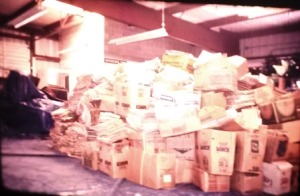
Although the Market was destroyed, it slightly damaged the old ice house allowing the records to be rescued from the blaze. According to the archivist, the documents suffered from water damage. The archivist was called upon to supervise the transfer of these records to a temporary store room in the Ministry of Works compound. Most of the records were moved by Saturday the 15th of June 2015. The job was completed by the end of the week and the ice house was subsequently demolished. By the next year the records were in the custodianship of The Public Records Office (now The Department of Archives) which operated out of three facilities.The rescued records were then moved to the Mosko building in the Ministry of Development with the kind permission of that Ministry. Shelving had been installed by The Archives Department and there the records were sorted listed and boxed. (Department of Archives Annual Report 1975)
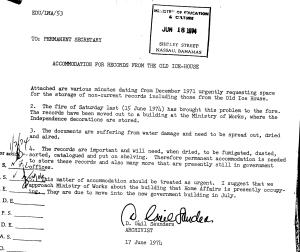
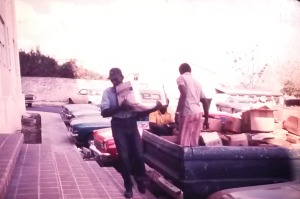
Today, these records are widely sought by researchers as they provide a unique insight into the administrative framework of the Colonial Secretary’s Office. The Colonial Secretary was considered the chief public servant responsible for the administration of goverment. All government functions were corresponded through this office and thus this deposit is one of the largest of the holdings to date. The fire in a sense brought to the fore the need for proper storage of non-current files. Since then, these records are presently housed in the Records Center located onsite at The Department of Archives Nassau, Bahamas.
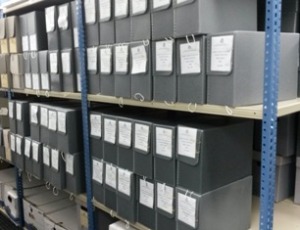
Photos (used with permission) from The Department of Archives Nassau Bahamas.
The Tribune. Saturday, June 15th 1974. P.1
Department of Archives Annual Report 1975.
Correspondence Re: Accommodation For Records from The Old Ice House. June 18th 1974. Department of Archives, Ministry of Education File 1974.
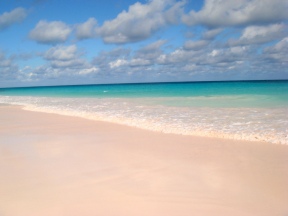
Leave a comment